Angelica Aviles-Rivero
Bridging Annotation Gaps: Transferring Labels to Align Object Detection Datasets
Jun 06, 2025Abstract:Combining multiple object detection datasets offers a path to improved generalisation but is hindered by inconsistencies in class semantics and bounding box annotations. Some methods to address this assume shared label taxonomies and address only spatial inconsistencies; others require manual relabelling, or produce a unified label space, which may be unsuitable when a fixed target label space is required. We propose Label-Aligned Transfer (LAT), a label transfer framework that systematically projects annotations from diverse source datasets into the label space of a target dataset. LAT begins by training dataset-specific detectors to generate pseudo-labels, which are then combined with ground-truth annotations via a Privileged Proposal Generator (PPG) that replaces the region proposal network in two-stage detectors. To further refine region features, a Semantic Feature Fusion (SFF) module injects class-aware context and features from overlapping proposals using a confidence-weighted attention mechanism. This pipeline preserves dataset-specific annotation granularity while enabling many-to-one label space transfer across heterogeneous datasets, resulting in a semantically and spatially aligned representation suitable for training a downstream detector. LAT thus jointly addresses both class-level misalignments and bounding box inconsistencies without relying on shared label spaces or manual annotations. Across multiple benchmarks, LAT demonstrates consistent improvements in target-domain detection performance, achieving gains of up to +4.8AP over semi-supervised baselines.
Contrastive Learning with Dynamic Localized Repulsion for Brain Age Prediction on 3D Stiffness Maps
Aug 01, 2024Abstract:In the field of neuroimaging, accurate brain age prediction is pivotal for uncovering the complexities of brain aging and pinpointing early indicators of neurodegenerative conditions. Recent advancements in self-supervised learning, particularly in contrastive learning, have demonstrated greater robustness when dealing with complex datasets. However, current approaches often fall short in generalizing across non-uniformly distributed data, prevalent in medical imaging scenarios. To bridge this gap, we introduce a novel contrastive loss that adapts dynamically during the training process, focusing on the localized neighborhoods of samples. Moreover, we expand beyond traditional structural features by incorporating brain stiffness, a mechanical property previously underexplored yet promising due to its sensitivity to age-related changes. This work presents the first application of self-supervised learning to brain mechanical properties, using compiled stiffness maps from various clinical studies to predict brain age. Our approach, featuring dynamic localized loss, consistently outperforms existing state-of-the-art methods, demonstrating superior performance and laying the way for new directions in brain aging research.
HAMLET: Graph Transformer Neural Operator for Partial Differential Equations
Feb 05, 2024Abstract:We present a novel graph transformer framework, HAMLET, designed to address the challenges in solving partial differential equations (PDEs) using neural networks. The framework uses graph transformers with modular input encoders to directly incorporate differential equation information into the solution process. This modularity enhances parameter correspondence control, making HAMLET adaptable to PDEs of arbitrary geometries and varied input formats. Notably, HAMLET scales effectively with increasing data complexity and noise, showcasing its robustness. HAMLET is not just tailored to a single type of physical simulation, but can be applied across various domains. Moreover, it boosts model resilience and performance, especially in scenarios with limited data. We demonstrate, through extensive experiments, that our framework is capable of outperforming current techniques for PDEs.
TrafficMOT: A Challenging Dataset for Multi-Object Tracking in Complex Traffic Scenarios
Nov 30, 2023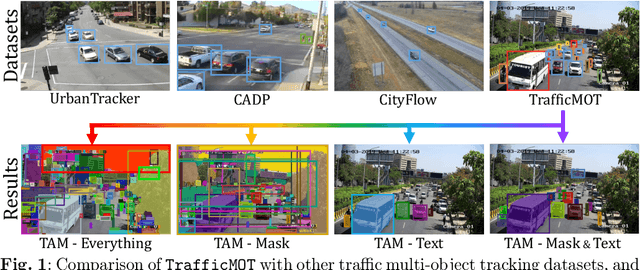
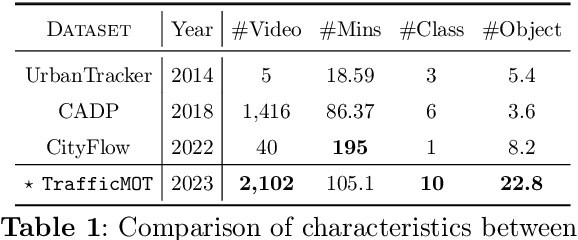
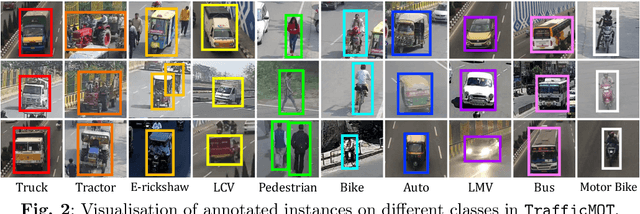
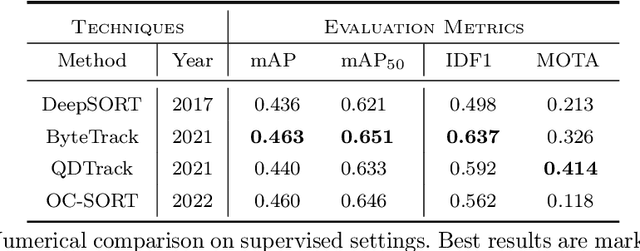
Abstract:Multi-object tracking in traffic videos is a crucial research area, offering immense potential for enhancing traffic monitoring accuracy and promoting road safety measures through the utilisation of advanced machine learning algorithms. However, existing datasets for multi-object tracking in traffic videos often feature limited instances or focus on single classes, which cannot well simulate the challenges encountered in complex traffic scenarios. To address this gap, we introduce TrafficMOT, an extensive dataset designed to encompass diverse traffic situations with complex scenarios. To validate the complexity and challenges presented by TrafficMOT, we conducted comprehensive empirical studies using three different settings: fully-supervised, semi-supervised, and a recent powerful zero-shot foundation model Tracking Anything Model (TAM). The experimental results highlight the inherent complexity of this dataset, emphasising its value in driving advancements in the field of traffic monitoring and multi-object tracking.
CDiffMR: Can We Replace the Gaussian Noise with K-Space Undersampling for Fast MRI?
Jun 25, 2023Abstract:Deep learning has shown the capability to substantially accelerate MRI reconstruction while acquiring fewer measurements. Recently, diffusion models have gained burgeoning interests as a novel group of deep learning-based generative methods. These methods seek to sample data points that belong to a target distribution from a Gaussian distribution, which has been successfully extended to MRI reconstruction. In this work, we proposed a Cold Diffusion-based MRI reconstruction method called CDiffMR. Different from conventional diffusion models, the degradation operation of our CDiffMR is based on \textit{k}-space undersampling instead of adding Gaussian noise, and the restoration network is trained to harness a de-aliaseing function. We also design starting point and data consistency conditioning strategies to guide and accelerate the reverse process. More intriguingly, the pre-trained CDiffMR model can be reused for reconstruction tasks with different undersampling rates. We demonstrated, through extensive numerical and visual experiments, that the proposed CDiffMR can achieve comparable or even superior reconstruction results than state-of-the-art models. Compared to the diffusion model-based counterpart, CDiffMR reaches readily competing results using only $1.6 \sim 3.4\%$ for inference time. The code is publicly available at https://github.com/ayanglab/CDiffMR.
TFPnP: Tuning-free Plug-and-Play Proximal Algorithm with Applications to Inverse Imaging Problems
Dec 11, 2020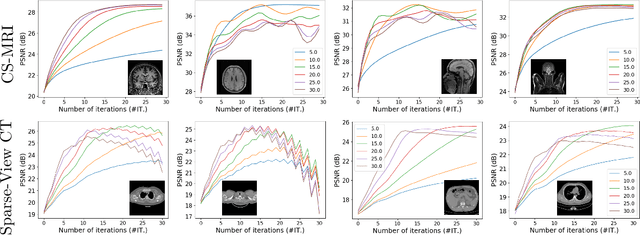
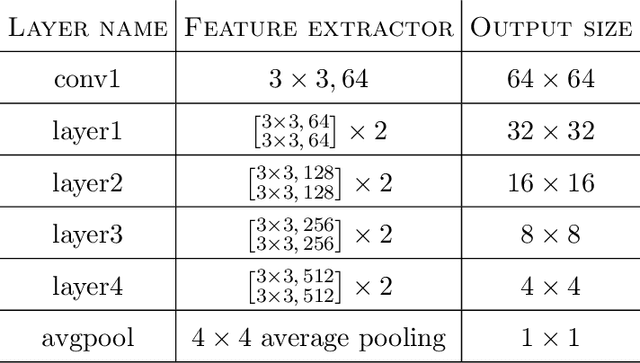


Abstract:Plug-and-Play (PnP) is a non-convex framework that combines proximal algorithms, for example alternating direction method of multipliers (ADMM), with advanced denoiser priors. Over the past few years, great empirical success has been obtained by PnP algorithms, especially for the ones integrated with deep learning-based denoisers. However, a crucial issue of PnP approaches is the need of manual parameter tweaking. As it is essential to obtain high-quality results across the high discrepancy in terms of imaging conditions and varying scene content. In this work, we present a tuning-free PnP proximal algorithm, which can automatically determine the internal parameters including the penalty parameter, the denoising strength and the termination time. A core part of our approach is to develop a policy network for automatic search of parameters, which can be effectively learned via mixed model-free and model-based deep reinforcement learning. We demonstrate, through a set of numerical and visual experiments, that the learned policy can customize different parameters for different states, and often more efficient and effective than existing handcrafted criteria. Moreover, we discuss the practical considerations of the plugged denoisers, which together with our learned policy yield to state-of-the-art results. This is prevalent on both linear and nonlinear exemplary inverse imaging problems, and in particular, we show promising results on compressed sensing MRI, sparse-view CT and phase retrieval.
A Three-Stage Self-Training Framework for Semi-Supervised Semantic Segmentation
Dec 01, 2020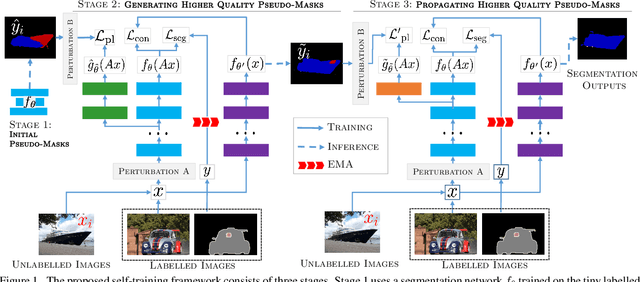
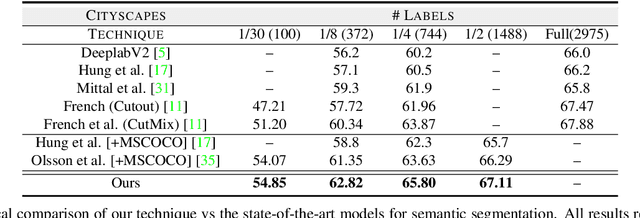

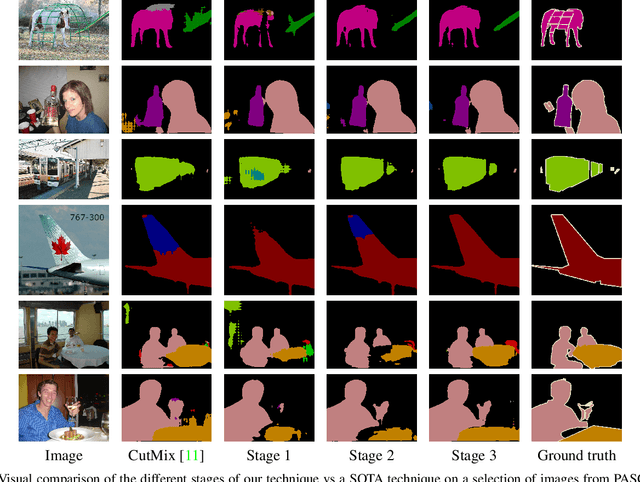
Abstract:Semantic segmentation has been widely investigated in the community, in which the state of the art techniques are based on supervised models. Those models have reported unprecedented performance at the cost of requiring a large set of high quality segmentation masks. To obtain such annotations is highly expensive and time consuming, in particular, in semantic segmentation where pixel-level annotations are required. In this work, we address this problem by proposing a holistic solution framed as a three-stage self-training framework for semi-supervised semantic segmentation. The key idea of our technique is the extraction of the pseudo-masks statistical information to decrease uncertainty in the predicted probability whilst enforcing segmentation consistency in a multi-task fashion. We achieve this through a three-stage solution. Firstly, we train a segmentation network to produce rough pseudo-masks which predicted probability is highly uncertain. Secondly, we then decrease the uncertainty of the pseudo-masks using a multi-task model that enforces consistency whilst exploiting the rich statistical information of the data. We compare our approach with existing methods for semi-supervised semantic segmentation and demonstrate its state-of-the-art performance with extensive experiments.
Tuning-free Plug-and-Play Proximal Algorithm for Inverse Imaging Problems
Feb 22, 2020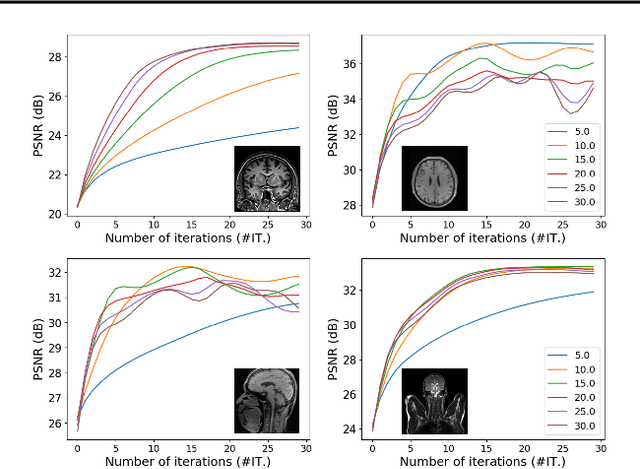

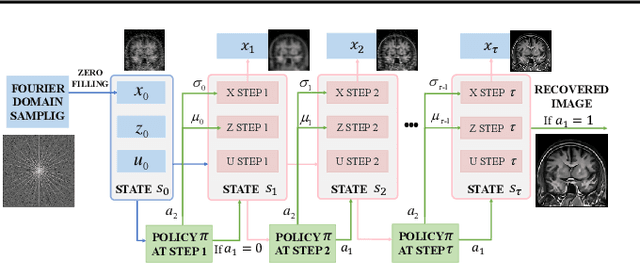
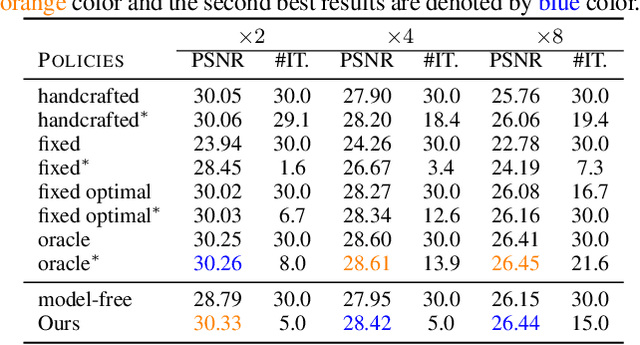
Abstract:Plug-and-play (PnP) is a non-convex framework that combines ADMM or other proximal algorithms with advanced denoiser priors. Recently, PnP has achieved great empirical success, especially with the integration of deep learning-based denoisers. However, a key problem of PnP based approaches is that they require manual parameter tweaking. It is necessary to obtain high-quality results across the high discrepancy in terms of imaging conditions and varying scene content. In this work, we present a tuning-free PnP proximal algorithm, which can automatically determine the internal parameters including the penalty parameter, the denoising strength and the terminal time. A key part of our approach is to develop a policy network for automatic search of parameters, which can be effectively learned via mixed model-free and model-based deep reinforcement learning. We demonstrate, through numerical and visual experiments, that the learned policy can customize different parameters for different states, and often more efficient and effective than existing handcrafted criteria. Moreover, we discuss the practical considerations of the plugged denoisers, which together with our learned policy yield state-of-the-art results. This is prevalent on both linear and nonlinear exemplary inverse imaging problems, and in particular, we show promising results on Compressed Sensing MRI and phase retrieval.
Two Cycle Learning: Clustering Based Regularisation for Deep Semi-Supervised Classification
Jan 15, 2020



Abstract:This works addresses the challenge of classification with minimal annotations. Obtaining annotated data is time consuming, expensive and can require expert knowledge. As a result, there is an acceleration towards semi-supervised learning (SSL) approaches which utilise large amounts of unlabelled data to improve classification performance. The vast majority of SSL approaches have focused on implementing the \textit{low-density separation assumption}, in which the idea is that decision boundaries should lie in low density regions. However, they have implemented this assumption by treating the dataset as a set of individual attributes rather than as a global structure, which limits the overall performance of the classifier. Therefore, in this work, we go beyond this implementation and propose a novel SSL framework called two-cycle learning. For the first cycle, we use clustering based regularisation that allows for improved decision boundaries as well as features that generalises well. The second cycle is set as a graph based SSL that take advantages of the richer discriminative features of the first cycle to significantly boost the accuracy of generated pseudo-labels. We evaluate our two-cycle learning method extensively across multiple datasets, outperforming current approaches.
Deep Reflection Prior
Dec 08, 2019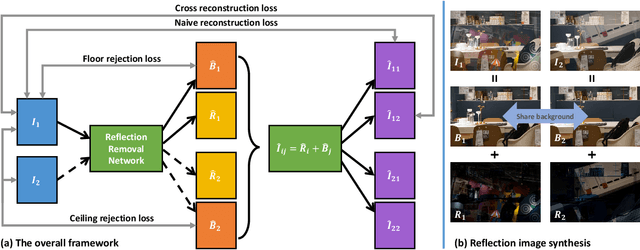
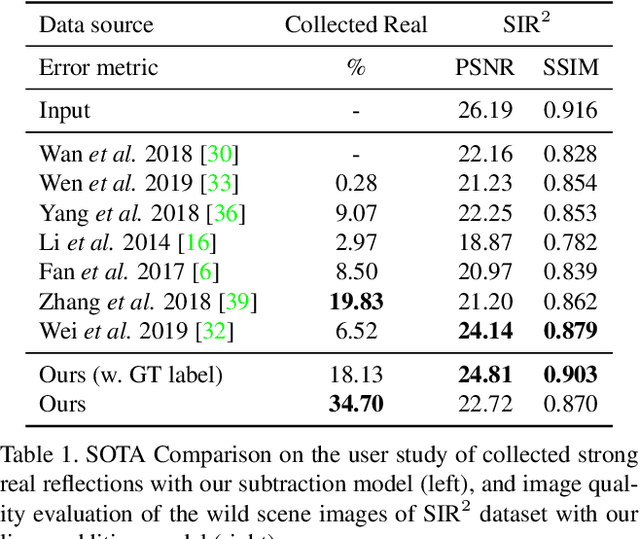

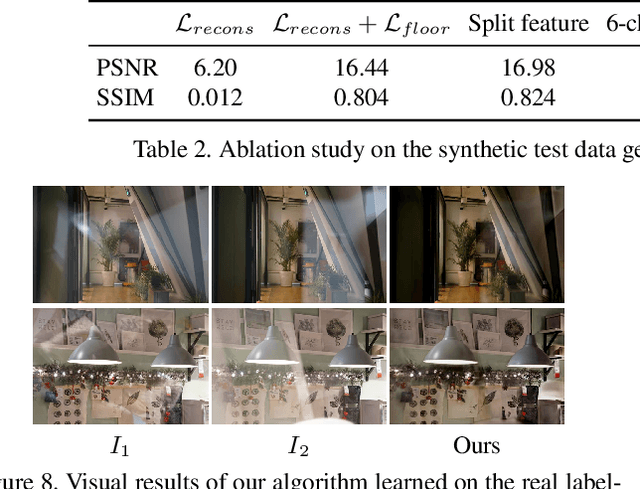
Abstract:Reflections are very common phenomena in our daily photography, which distract people's attention from the scene behind the glass. The problem of removing reflection artifacts is important but challenging due to its ill-posed nature. Recent learning-based approaches have demonstrated a significant improvement in removing reflections. However, these methods are limited as they require a large number of synthetic reflection/clean image pairs for supervision, at the risk of overfitting in the synthetic image domain. In this paper, we propose a learning-based approach that captures the reflection statistical prior for single image reflection removal. Our algorithm is driven by optimizing the target with joint constraints enhanced between multiple input images during the training stage, but is able to eliminate reflections only from a single input for evaluation. Our framework allows to predict both background and reflection via a one-branch deep neural network, which is implemented by the controllable latent code that indicates either the background or reflection output. We demonstrate superior performance over the state-of-the-art methods on a large range of real-world images. We further provide insightful analysis behind the learned latent code, which may inspire more future work.
 Add to Chrome
Add to Chrome Add to Firefox
Add to Firefox Add to Edge
Add to Edge